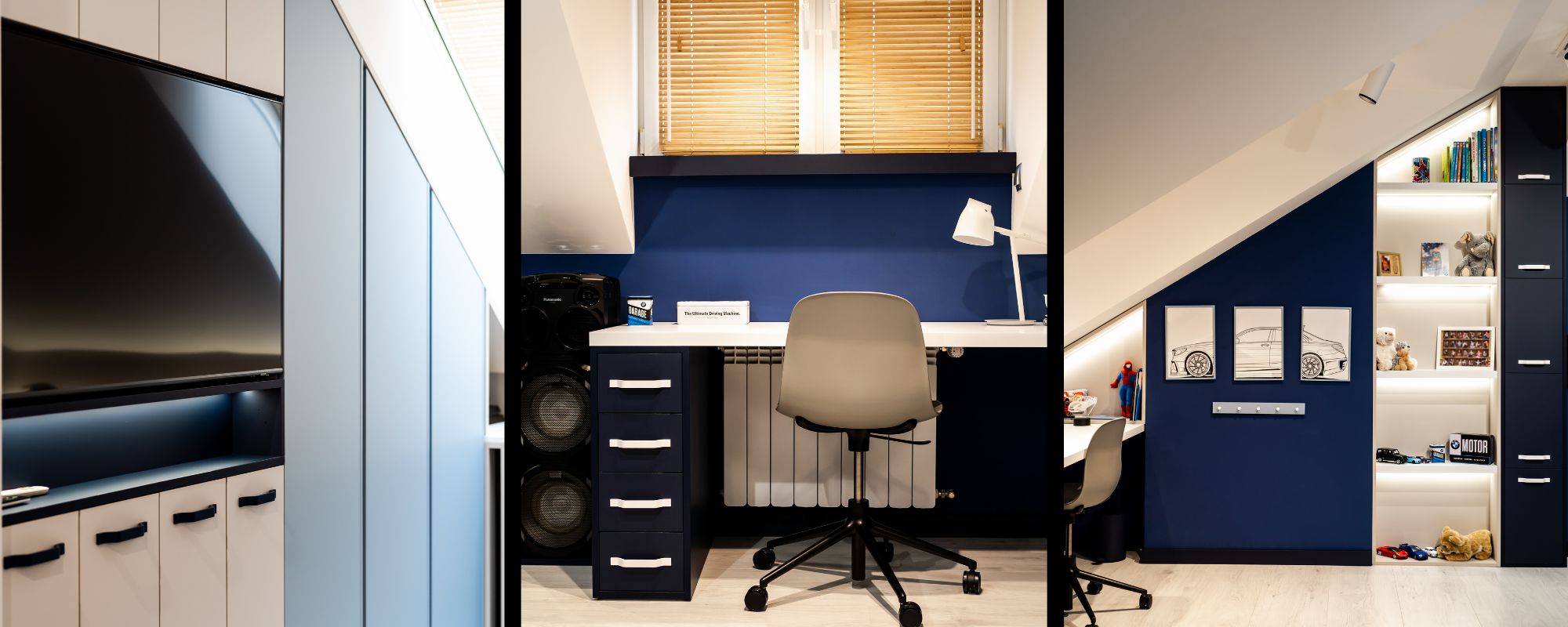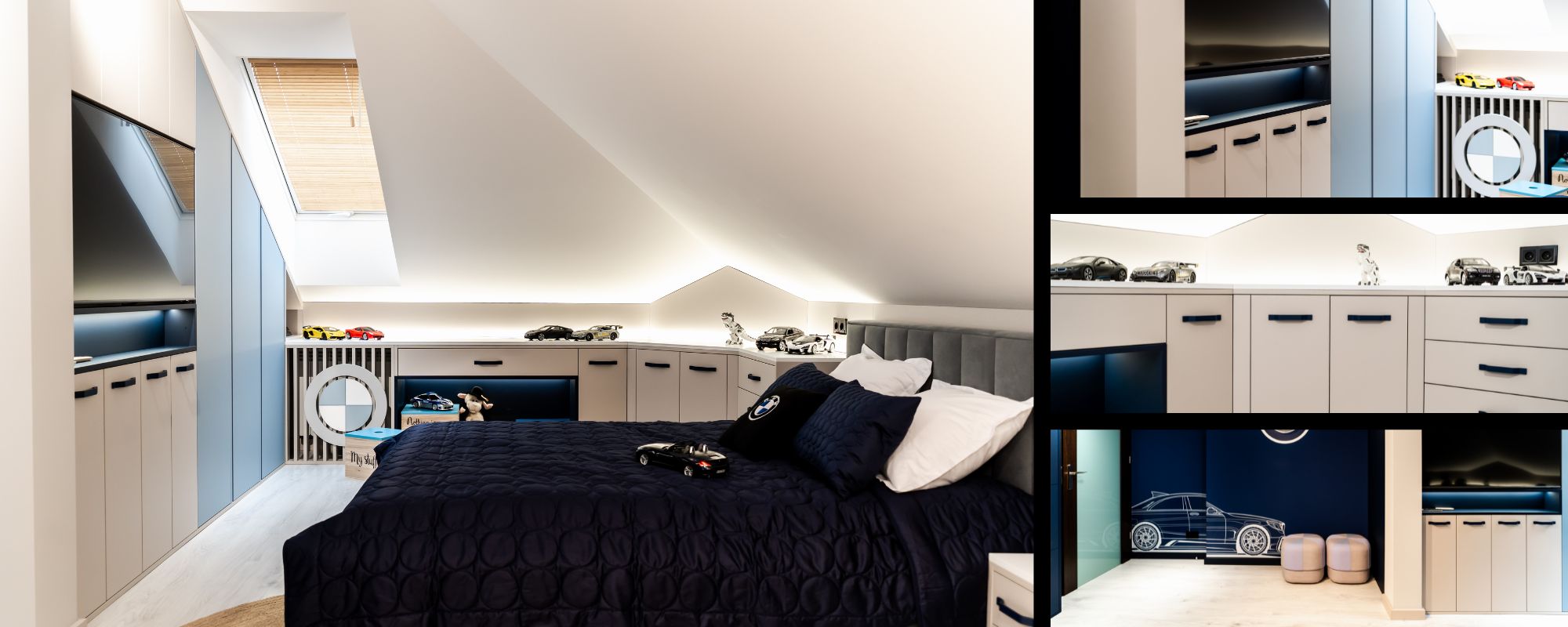A room for a child to a big problem ...? About the interior design of a children's room.
A children's room is a place where our children learn, play and spend their free time. The child should feel comfortable and safe in it. The materials used in the construction of all equipment should be made of durable and sturdy materials.
We asked our friend interior designers - Klaudia Dawidowska from the Create Design studio and Karina Wiciak from the WamHouse studio about the aspects that are worth considering when arranging a children's room. They listed four, in their opinion, the most important:
- Room user needs
- Functionality
- ergonomics
- Budget
1. The needs of the room user
A child's room is a room with special requirements, because a child is someone special to us, requiring gentle, but also responsible treatment. In addition, the child changes and grows, and thus its needs change.
At the beginning, we must therefore ask ourselves - How long do we want the child to enjoy this room? What are the visual expectations of the child himself? What interests do you have that inspire you? The answer to them will make it easier for us to choose the style and leitmotif, says Klaudia Dawidowska.
It is very important, and often overlooked in independent design - long-term planning. Particular attention should be paid to the selection of appropriate furniture that will "grow" with the child, as well as to the selection of appropriate materials (preferably durable) and colors - which will be universal as far as possible.
If we want to create a room for an early school child that will neither overwhelm with colors nor get bored too quickly, it is worth designing it as if we were arranging it for a teenager. So no "childish" shapes and motifs on the furniture. An exception, however, may be furniture handles, which in the future we will be able to quickly and easily replace with more "serious", emphasizes Karina Wiciak.
To diversify the decor, we also recommend using, for example, interesting wallpaper on one of the walls. There are many types and designs on the market, so everyone will surely find something for themselves. It is also an easier solution if you want to change the arrangement of the room than repainting the walls. An alternative to wallpaper can also be wall stickers, slats and even MDF boards that will imitate wood or other material.
If the child is physically active, it will be a good idea to mount a gymnastic ladder, climbing wall, rope or swing.
Talk to your child about their interests, ideas and needs.

2. The functionality and base of the room
The next step is to consider what possibilities the room itself has? Do its size and dimensions allow you to place everything that is necessary? The base, i.e. the basic arrangement of furniture, is very important. Remember in this step to divide the room into zones. The ideal solution is a learning, fun and relaxation zone.
If the layout allows, try to place the desk as close to the window as possible to ensure the flow of daylight. The bed should be as far away from the desk as possible. A place to store toys, clothes, books is also a very important element. The more of this space, the greater the chance of order, both literal and visual.
3. Ergonomics
Convenience is extremely important. It is important that the child has free access to his belongings. It is worth paying attention to solutions that will serve the child for a long time, e.g. an adjustable desk, hangers, a chair or a bed. The shapes of furniture should be simple and universal, and unique (e.g. related to fairy-tale motifs) decorations should be introduced in the form of easy-to-replace accessories, i.e., for example - boxes, pillows, free-standing lamps.
Colors are very important and have a strong influence on us, emphasizes Klaudia Dawidowska. Avoid bright colors in your child's room. If they are to appear, it will be in the form of accessories, such as pillows, poufs or pictures. One dominant color and the other neutral will be a great base for colorful toys, books or other elements of equipment.
A child's room is usually full of "gaudy" decorations in the form of a large number of colorful toys, books, boxes, etc. so a subdued base (e.g. fronts in gray or navy blue) will not create unnecessarily additional optical chaos. Flashy colors of furniture can wear out quickly, as well as not match the new colors of the walls in the future. An exception, however, may be the fronts themselves in the selected color, which can be relatively easily replaced in the future with new ones that match the new interior styling. Of course, there will always be supporters of furniture in childish shapes and motley colors, adds Karina Wiciak, so the most important thing when arranging a room is also to ask yourself - when are we planning the next renovation or replacement of furniture and to design and arrange the room in this regard.

Well-thought-out and selected lighting also plays an important role. There should be a study lamp on the desk, a bedside lamp and general lighting of the entire room as well as all kinds of decorative lamps or LED strips. It is worth paying attention to the location of the main light switches, e.g. by the bed, so that the child does not have to go to the toilet in the dark at night. Let's empathize with the child and his needs and try to take this into account.
4. Budget
The budget should also not be forgotten, because it defines many of our choices. If we can afford a slightly higher expenditure, we encourage you to make furniture from a carpenter. Then we will use the storage space optimally. You can also make a climbing wall or a bunk bed.
Inspiration - children's rooms.
Sample projects prepared by Klaudia Dawidowska from the Create Design. interior design studio.
The first project shows a room for 7-year-old Staś. The boy is interested in space, hence it became the leitmotif. The room is dominated by navy blue and cream colors. Staś has always dreamed of a bunk bed and a sports corner. The room is complemented by a desk, a comfortable armchair and a place for books.

The second project is the room of 6-year-old Ania. It is distinguished by completely neutral colors. It is dominated by grays and wood. The project is neutral in terms of gender and interests, so that for at least 6-8 years it will "grow" with Ania. The room is completed with a wooden swing and a functional sofa.

Design of a room for a small automotive fan, where details are of great importance, prepared by Karina Wiciak, WamHouse.
The owner of the room is still a child and has specific (automotive) preferences, even if he changes them in the future, the interior will "grow" with the child and the currently important "details" can be replaced relatively quickly (and relatively easily).
 We would like to thank Kaudia Dawidowska from Create Design and Karina Wiciak from WamHouse for the conversation and valuable tips. We hope that they will be helpful to you when arranging rooms for your children.
We would like to thank Kaudia Dawidowska from Create Design and Karina Wiciak from WamHouse for the conversation and valuable tips. We hope that they will be helpful to you when arranging rooms for your children.